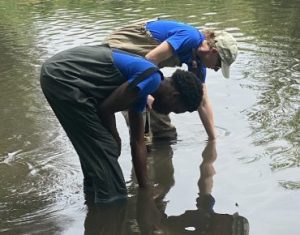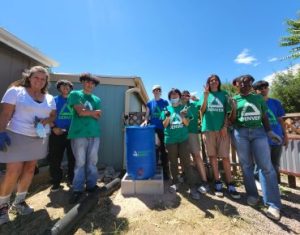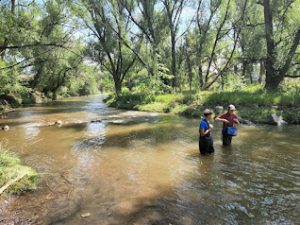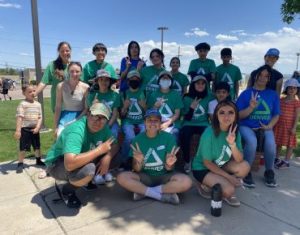Testing the Waters: Moving Towards Water Equity
Our lives depend on water, from drinking and sanitation to growing food and maintaining ecosystems. But water equity is a growing crisis in many parts of the country. Intensive farming drains the aquifers and endangers groundwater in California’s Central Valley. In Alabama’s “Black Belt” region, most homes have inadequate sewer systems that cause frequent overflows and pollution. And eight months after floods inundated Jackson, Mississippi, residents still lack clean drinking water. The water crisis affects us all, but the most devastating impacts are in low-income areas and communities of color. Closing the water equity gap will make it possible for people to enjoy and benefit from their local waters without risking their health.
The Lower Bear Creek in Sheridan, Colorado, serves as a place for recreation and for residents to cool off during the hot summer heat. The creek flows into the South Platte River to the east, which is the primary drinking water source for the Front Range. According to the US EPA, the South Platte River is also a pathogen-impaired water body. To address the contamination in the South Platte River and the Bear Creek watershed, Groundwork Denver launched the Water Program through a multi-partner collaboration. With community and youth at the heart of the program, they have successfully reduced the number of pathogens in Bear Creek and reduced the amount of stormwater runoff entering the watershed.
Jessica Swindon, Director of Groundwork Denver’s Water Program, discussed the program’s vision for restoring Bear Creek with community-led initiatives that reconnect residents with their local water sources.
What is the inspiration behind Groundwork Denver’s Water Program, and what is your vision for the community?
The Water Program was launched in 2014 to monitor water quality and provide safety and water equity for residents of Sheridan, a city near Denver and home to primarily communities of color who use Bear Creek regularly. When we first began water quality testing in the Sheridan neighborhoods a decade ago, we documented E. coli levels in the water nearly 19 times greater than what is considered safe in the state. Meanwhile, upstream, the water runs clean and clear. Due to the shocking level of contaminants, a joint effort by local municipalities, community groups, and Groundwork Denver worked to create a Watershed Plan. Shortly after, they launched the Water Program to address water quality issues in the watershed, focusing on monitoring contaminants like phosphorus, nitrogen, trash, and E. coli bacteria.
 Why is Bear Creek a focus area for water protection, and why are communities in Sheridan more vulnerable to water quality issues?
Why is Bear Creek a focus area for water protection, and why are communities in Sheridan more vulnerable to water quality issues?
Bear Creek flows west to east and runs into the South Platte River, a major tributary providing drinking water for residents throughout Colorado and further south. Through monitoring, we saw that the water is very clean when released from the reservoir. As it travels through the more urbanized areas, it picks up pollutants from roads and streets, like E. coli, industrial chemicals, and trash. The portion of the stream that runs through Sheridan is the most degraded section and, from our data, has the highest levels of E. coli. It is also lined with a mix of industrial businesses, from the metal recycling plant and car mechanic shops to the highway less than twenty feet away. You don’t see that anywhere else along the waterway.
The Power of Community and Youth
The creek is essential to the residents’ lives for cooling down during sweltering temperatures or enjoying outdoor space with family. What is your approach to addressing water equity and centering the residents’ needs first?
We can’t stop E. coli from traveling from land into the creek, and we would never tell anyone not to go in the water. As part of the Water Program, we focus on raising awareness about water issues while creating a space for residents to be part of the monitoring and restoration efforts. Throughout the summer, we work with our Blue Team, employed youth who focus on water issues, to address Sheridan’s water equity and quality issues. As part of this program, youth receive training and experience in testing and monitoring water quality. They also receive training on installing green infrastructure like rain barrels and conducting no-cost home sprinkler audits. Through the audit program, we support fixing broken or leaky sprinkler systems and offer suggestions for conserving water and reducing runoff pollution. All materials for residents are provided in multiple languages, and we use several outreach methods to ensure accessibility.
Can you elaborate more on the projects that are going into raising awareness around water quality and restoring the creek? Are you seeing any impacts yet from your initiative?
As part of the program, we work with partners like the City of Sheridan, other community groups, and the Blue Team to manage the stream bank and surrounding green spaces by removing invasive species and replanting native vegetation to improve water quality. Last summer, we did sixty irrigation audits at residents’ homes to raise awareness about water conservation. If somebody is watering their lawn every day, and it’s hitting the sidewalk every day, it’s washing those pollutants down into storm drains that flow directly into the creek. Through these efforts, we’ve seen a reduction in the neighborhood’s stormwater runoff and a slight decrease in E. coli levels; however, levels still exceed state standards.
Alongside our environmental impact, we’re creating opportunities for youth in the community to become future water protectors through our water programs. For many young adults on the Blue Team, this is their first paid job. They’re getting training in green infrastructure and learning what it means to be an environmental steward. They are so connected to the work that they bring their families and friends into these conversations. The Blue Team often co-leads volunteer events and discusses what they do on the team, inspiring action and raising awareness in the process. Engaging the community in this way can raise awareness about water equity and change people’s relationship with water and their environment.
Regarding Groundwork Denver’s Water Program, what are some plans already in place, and what are your visions for the future?
I hope to see more opportunities for youth to take on leadership roles and learn practical skills that they can use in their next career or job. Many of our youth would have never been exposed to this kind of work unless they were a part of the Blue Team at Groundwork Denver. Inspiring them to become water protectors and environmental stewards is a powerful motivator.
Building off of the work we’ve been doing with the Blue Team, I would like to engage youth in the construction of rain gardens. This skill presents a new learning opportunity. They can learn more about water filtration and how plants can reduce pollutants so that it’s cleaner when rainwater or urban runoff reaches the groundwater.
Our success so far is due to the community we’ve built and the partnerships we’ve established. We currently work with Sheridan Inspire, a network of community groups, nonprofits, and the city that have all agreed to meet regularly to discuss our projects and find ways to collaborate. We also partner with the EPA, and the water municipality, Denver Water. It’s always amazing to see how many people care about Denver’s water issues. I want to keep developing these meaningful relationships so that together, we can provide our communities with access to safe and healthy waters. Explore more about the water initiatives at Groundwork Denver and The South Platte River Urban Waters Partnership, a collaborative group working to protect and restore lands and water in the South Platte River basin.
Explore more about the water initiatives at Groundwork Denver and The South Platte River Urban Waters Partnership, a collaborative group working to protect and restore lands and water in the South Platte River basin.


